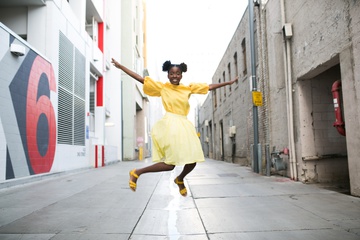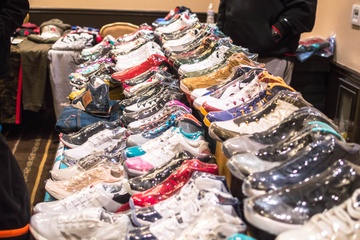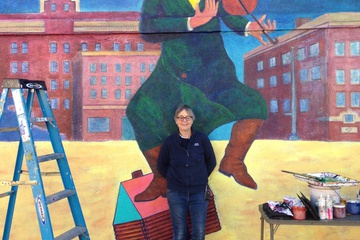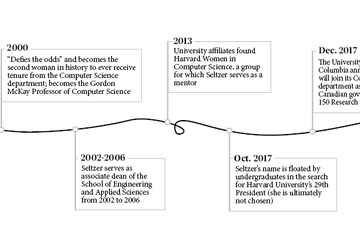Heels click neatly on the slick pavement; fog settles faintly down on a warm February night. It’s hard to keep up with Elsie A. Tellier ’19 as she marches down the mostly empty streets, talking—and walking—a mile a minute.
“A lot of people in my freshman year knew me as that one girl who made this really long post in the Facebook page explaining the history of women’s sizing and why women’s sizing is messed up.” She pauses. “It’s a long story.”
Today, Tellier is wearing blush-colored heels, light-wash jeans, a magenta blouse, and a coral sweater. It’s “pretty obvious” that pink is her favorite color, she says. Only one accessory doesn’t match the theme: a cotton face mask adorned with Disney characters—Mickey Mouse, Minnie Mouse, Donald Duck—which is, she explains, the only design available in her size.
***
She’s wearing the mask because it’s flu season, and, as she explains, she has to be “careful about getting sick.” Tellier has cystic fibrosis, a genetic disorder that affects her lungs, pancreas, and other organs.
“I like to explain it by saying that the one lever that manages the salt and water in my body just decided to quit, and so all of my organs are filled with a thick and sticky mucus,” she says. We’re sitting in her room now, a quiet single in Leverett with a view of the Memorial Drive headlights streaming by, and beyond, the Charles, aglow in the dusk.
Tellier’s room is not quite cluttered, not quite spare—little white roses garland one side, where her bed and desk are, and her wardrobe is filled with more shades of pinks and creams than I knew existed. On the other side of her room, “Star Wars” and anime posters mingle on the wall. Princess Leia and Sailor Moon figurines dot her shelves and cabinets. Her wheelchair rests near the door. The right wheel is painted with swirling roses, petals flying in the wind, and the left features a constellation of stars and planets, light pinks and blues.
{shortcode-d397a68706d3e761232a93879651314a9c1af367}
She’s telling me about cystic fibrosis, or CF, and how, unlike some other chronic illnesses, it’s both congenital and incurable. “It’s not something that’s reversible; it’s not something that can be treated. It can only be sustained,” she says. “Everything I do to treat myself is just a life-sustaining treatment, something to keep me alive longer.”
The disease’s congenital nature also differentiates it from other illnesses which are “biographical disruptions [that] onset later in life,” she says. “It’s not something that you can think of in this narrative of pre-CF and post-CF.” Instead, it’s an “immediate identity.”
Tellier says she was diagnosed at 12. The diagnosis finally explained why she was “continuously sick” as a child. “Certain things changed,” she says, “but it was never like the symptoms didn’t change, they just got worse over time.”
“My identity as someone who’s sick”—her consonants take on a hard edge—“or where it felt like something was really wrong, that didn’t change.”
***
Tellier was raised by her aunt and father in Winnipeg, Manitoba. Winnipeggers “basically live in Hell,” she says, laughing. Winnipeg temperatures range from 40 below in winter to near 100 in summer.
On the day of her diagnosis, she says she made a decision: “I wanted to go to college before I died. At the time, I was told my life expectancy was 30… I was 12. I was told basically [that] my life was half over.” Her eyes roam around her room as she remembers.
Despite missing nearly two years of high school due to her illness, Tellier graduated first in her class. Though she didn’t make her dream school—Oxford—she landed here, where she is concentrating in sociology.
It was during those high school years that clothing became more than something she wore for Tellier. As a child, she would marvel at models on television and in the pages of “Harper’s Bazaar” and “Vogue.” Yet fashion remained “an ideal, something that I couldn’t afford but could appreciate as some art form.”
“I think [my interest] grew as I stopped thinking about fashion as something that was exclusively what people put on models,” she says.
“Over time fashion became a really comfortable space for me to be, because I was never really happy with my body. Not quite in a body image way, but because I was always sick—I’m so used to seeing my body as something that’s…” A pause. “‘Defective’ is not a nice word to use for myself, but I never had a sense of really liking my body, because it fails me.”
So fashion became “something that was fun, and something that got me up in the morning. It was like, I need to get out the door because people need to see me today, they have to see how cute I look,” she says, smiling.
Her dedication to fashion grew as she started sharing it with other people on her Instagram, Twitter, and Tumblr. In the spring of 2016, she posted a picture of herself dressed as Princess Leia, seated in her wheelchair. It accumulated nearly 100,000 notes and responses from “a lot of other young people who were disabled and had chronic illnesses, [who] expressed how great it was to see someone like them looking cute and having fun.” The post’s popularity culminated in Tellier meeting Carrie Fisher, a photo of which she shared with the caption, “UPDATE: SPACE MOM WANNABE MEETS REAL SPACE MOM!!!”
“Over time, sharing my fashion and talking about fashion became a way to cope with chronic illness, and a way not to hide my illness, but to make things that are typically seen as unattractive and generic be fun and creative,” she says. “Wheelchairs aren’t usually thought of as cute, but I said, ‘I’m gonna paint my wheelchair to make it cute.’ I would often wear cannulas—cannulas are never cute, but if I have to wear it in public, I’m going to tie a ribbon around it, bedazzle my oxygen tank.
“So it’s finding cute covers, finding ways you can deal with different medical supplies but still make it cute, still make it a part of your personality. My idea of fashion is never to dictate a certain sense of style… but to make sure that for my own sake, I wasn’t feeling controlled by my illness.”
***
We’ve reached Harvard Square by now, and we duck inside an Ann Taylor. Tellier greets a saleswoman with a cheery “Hello!” and removes her mask, unwinding the slender ear loops with care. She’d brought up certain “fashion rules” earlier, and I ask her—nervously—if I’m breaking any rules today.
“You’re fine!” she says, not looking up from a rack of blazers. “You can wear any four colors plus any neutral.” I nod, relieved.
A silence follows—I let her shop—until she begins to talk with a new urgency, unprompted.
“For me, I see fashion as the middle ground between people. Everyone has their own style,” she says. “I feel like when I dress up a lot and make my chair super cute… it breaks the ice for a lot of people, makes it easier to talk about me being in a chair, or my chair itself.
“I find that when some people see someone being disabled and dressing up and having fun, it helps challenge that stereotype that all disability is inherently terrible and your life sucks. Because it doesn’t. Not for the most part, anyways, not more than anyone else’s. There’s a lot of rhetoric, like, ‘Wow, it’s amazing that people just wake up in the morning!’ But we’re just living our lives. And part of that is dressing up and having fun, having fashion sense—or having no fashion sense. Either way, we’re normal people.”
She turns her attention briefly to a rack of pantsuits, and then looks back at me.
“I want to make sure that people acknowledge that I’m disabled and know that it’s a part of me, but it’s not the only part of me. It’s something I have to incorporate [into] the way I live and the way I dress, and so much of my life revolves around [the] schedule of being sick, and that doesn’t mean I can’t take that extra step of dressing up and making sure that I feel good in the morning. That I feel good about myself.”
We take one last circuit around the store and head back into the night. It’s stopped raining; the wet tarmac reflects the streetlights. In the early evening gloom, the white of her face mask is luminous.
— Magazine writer Alan R. Dai can be reached at alan.dai@thecrimson.com. This is the third installment of his fashion column, Live Fresh or Dai, in which he travels around the city to various people and places that are, however obliquely, fashion-related. Follow him on Twitter @dai_alan_dai.






